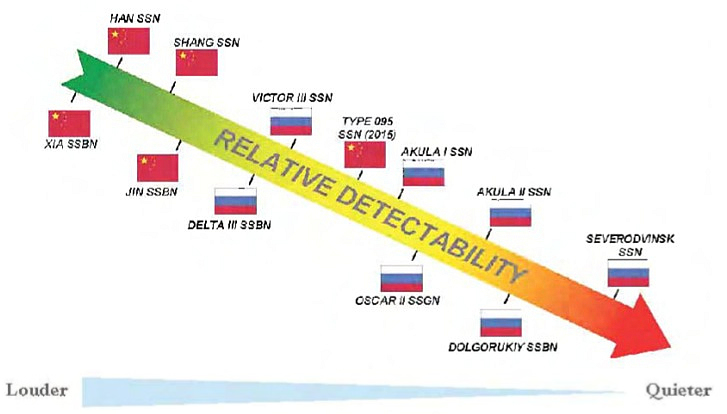 |
| China’s newest nuclear submarines are noisier than 1970s-era Soviet nuclear submarines. |
.
By Hans M. Kristensen
China’s new Jin-class ballistic missile submarine is noisier than the Russian Delta III-class submarines built more than 30 years ago, according to a report produced by the U.S. Navy’s Office of Naval Intelligence (ONI).
The report The People’s Liberation Army Navy: A Modern Navy With Chinese Characteristics, which was first posted on the FAS Secrecy News Blog and has since been removed from the ONI web site [but now back here; thanks Bruce], is to my knowledge the first official description made public of Chinese and Russian modern nuclear submarine noise levels.
Force Level
The report shows that China now has two Jin SSBNs, one of which is based at Hainan Island with the South Sea Fleet, along with two Type 093 Shang-class nuclear-powered attack submarines (SSN). The Jin was first described at Hainan in February 2008 and the two Shangs in September 2008. The second Jin SSBN is based at Jianggezhuang with the North Sea Fleet alongside the old Xia-class SSBN and four Han-class SSNs.
The report confirms the existence of the Type 095, a third-generation SSN intended to follow the Type 093 Shang-class. Five Type 095s are expected from around 2015. The Type-95 is estimated to be noisier than the Russian Akula I SSN built 20 years ago.
Missile Range
The ONI report states that the JL-2 sea-launched ballistic missile on the Jin SSBNs has a range of ~4,000 nautical miles (~7,400 km) “is capable of reaching the continental United States from Chinese littorals.” Not quite, unless Chinese littorals extend well into the Sea of Japan. Since the continental United States does not include Alaska and Hawaii, a warhead from a 7,400-km range JL-2 would fall into the sea about 800 km from Seattle. A JL-2 carrying penetration aids in addition to a warhead would presumably have a shorter range.
|
Julang-2 SLBM Range According to ONI |
 |
| Although the ONI report states that the Julang-2 can target the Continental United States, the range estimate it provides is insufficient to reach the lower 48 states or Hawaii. |
.
Alaska would be in range if the JL-2 is launched from the very northern parts of Chinese waters, but Hawaii is out of range unless the missile is launched from a position close to South Korea or Japan. The U.S. Defense Department’s 2009 report to Congress on the Military Power of the People’s Republic of China also shows the range of the JL-2 to be insufficient to target the Continental United States or Hawaii from Chinese waters. The JL-2 instead appears to be a regional weapon with potential mission against Russia and India and U.S. bases in Guam and Japan.
Patrol Levels
The report also states that Chinese submarine patrols have “more than tripled” over the past few years, when compared to the historical levels of the last two decades.
That sounds like a lot, but given that the entire Chinese submarine fleet in those two decades in average conducted fewer than three patrols per year combined, a trippling doesn’t amout to a whole lot for a submarine fleet of 63 submarines. According to data obtained from ONI under FOIA, the patrol number in 2008 was 12.
Since only the most capable of the Chinese attack submarines presumably conduct these patrols away from Chinese waters – and since China has yet to send one of its ballistic missile submarines on patrol – that could mean one or two patrols per year per submarine.
Implications
The ONI report concludes that the Jin SSBN with the JL-2 SLBM gives the PLA Navy its first credible second-strike nuclear capability. The authors must mean in principle, because in a war such noisy submarines would presumably be highly vulnerabe to U.S. or Japanese anti-submarine warfare forces. (The noise level of China’s most modern diesel-electric submarines is another matter; ONI says some are comparable to Russian diesel-electric submarines).
That does raise an interesting question about the Chinese SSBN program: if Chinese leaders are so concerned about the vulnerability of their nuclear deterrent, why base a significant portion of it on a few noisy platforms and send them out to sea where they can be sunk by U.S. attack submarines in a war? And if Chinese planners know that the sea-based deterrent is much more vulnerable than its land-based deterrent, why do they waste money on the SSBN program?
The answer is probably a combination of national prestige and scenarios involving India or Russia that have less capable anti-submarine forces.
This publication was made possible by a grant from Carnegie Corporation of New York and Ploughshares Fund. The statements made and views expressed are solely the responsibility of the author.
A military depot in central Belarus has recently been upgraded with additional security perimeters and an access point that indicate it could be intended for housing Russian nuclear warheads for Belarus’ Russia-supplied Iskander missile launchers.
The Indian government announced yesterday that it had conducted the first flight test of its Agni-5 ballistic missile “with Multiple Independently Targetable Re-Entry Vehicle (MIRV) technology.
While many are rightly concerned about Russia’s development of new nuclear-capable systems, fears of substantial nuclear increase may be overblown.
Despite modernization of Russian nuclear forces and warnings about an increase of especially shorter-range non-strategic warheads, we do not yet see such an increase as far as open sources indicate.